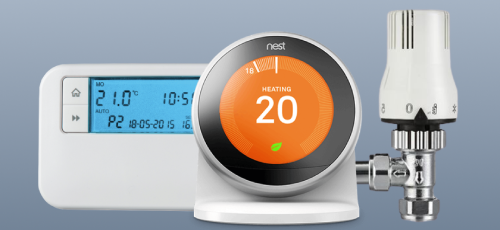
Central heating controls are often puzzling but they’re essential for efficiently managing the heating and hot water supply in your home. It may seem simple to some, but knowing how to manage the controls properly can improve energy efficiency in your home and save you tons of money on bills. You never know, you might just learn something new along the way.
According to the Energy Saving Trust, making small changes in your home, such as installing room smart thermostats and thermostatic radiator valves, could save you between £75-£155 a year. Even turning your heating down by 1°C could save you around £80 a year. Benefit from our handy guide on saving money on energy bills.
Boiler thermostat
Your boiler has two jobs: to supply you with hot water and to supply the radiators with hot water to heat your home. A boiler thermostat allows you to control the temperature of your central heating and hot water.
Your boiler doesn’t really need to be on throughout the day, especially if you are at work. To save money, programme your boiler to come on in the morning and at night, using the timer/programmer which will be discussed in this guide.
It is generally recommended that your hot water should be set at around 60°C and your radiators around 75°C.
Do not set your water temperature below 60°C as bacteria will grow and this can cause serious health risks. Setting the hot water temperature around 60°C will be toasty enough for you and too warm for bacteria to grow. Perfect.
Room thermostat
A room thermostat is located on a wall in your home, typically somewhere on the first floor, not near your boiler.
There are two types of room thermostats: analogue and digital. Digital thermostats are a modern and popular choice as they are known to be more accurate compared with the analogue thermostat which is a simple option for those who prefer a more straightforward display.
A room thermostat has a sensor inside which monitors the room temperature. If your home reaches the target temperature it is set to – the central heating system is turned off, when the room temperature drops – the central heating system is turned back on.
The room thermostat is an important control, as, without it, your boiler wouldn’t know when to stop supplying hot water to the radiators in your home.
It is recommended for energy efficiency reasons and to save money that you should set your daytime temperature around 20°C and your nighttime temperature anywhere around 16°C-19°C. The ideal room temperature is around 19°C to 21°C.
Thermostatic radiator valves
Thermostatic radiator valves are typically fitted to every radiator in your home. These valves allow you to control each individual room.
Thermostatic radiator valves usually have the numbers 1-5 on them. The higher the number, the more heat. If the radiators are on number 3 on the TRV, your room temperature will be around 20°C which is just right.
If you are looking to save money (and who isn’t?), try putting your radiators on low in rooms where you spend less time and close the doors on those rooms.
Boiler timer/programmer
All boilers have a timer for you to manage when your boiler turns on throughout the day and for how long. It’s best for your wallet if you set your boiler to come on for a few hours in the morning and a few hours at night.
Some more advanced boilers have the option to change the settings so that they are different on weekends to weekdays. This is really useful if you want a few extra hours in bed on a weekend and want to stay toasty.
A combi boiler heats hot water as required, so you don’t need to programme it. If you don’t yet have one of these in your home, it’s worth considering making the change to a combi boiler.
The buttons on your boiler’s timer/programmer can get confusing. Here is a breakdown of the basic controls found on a programmer/timer:
Boost
Some boilers have the option to ‘boost’. The boiler can be ‘boosted’ outside of your set time for hot water or heating.
Auto
The ‘auto’ option means that your heating and hot water will go on and off when they are programmed to do so.
On/24hrs
The ‘on’ or ‘24hrs’ button keeps your heating or hot water on all of the time.
Off
With the ‘off’ option your heating/hot water will remain off all day.
Modern ways of controlling the heating system in your home
With technology rapidly growing, it is now possible to control your heating and hot water through an app on your smartphone. As long as you have internet connection, you can control the heating in your home from anywhere. You can adjust the time that your heating and hot water comes on according to any unexpected delays at work, saving you some pennies.
Some apps even have the ability to use GPS to track when you are near home to turn the heating on and you can even adjust your home temperature according to the weather!
Get in touch with us
Speak with one of our specialists who’ll help you solve any mysteries involving heating and boiler controls. Alternatively, you can always message us on our Live Chat for advice.
Not happy with your current boiler’s controls and looking for a new one? We noticed that the heating industry isn’t fair on it’s customers. We sell quality boilers and smart home technology at a fair price. Contact us for more information or browse our website today for quality products at a very fair price.


Post a Comment